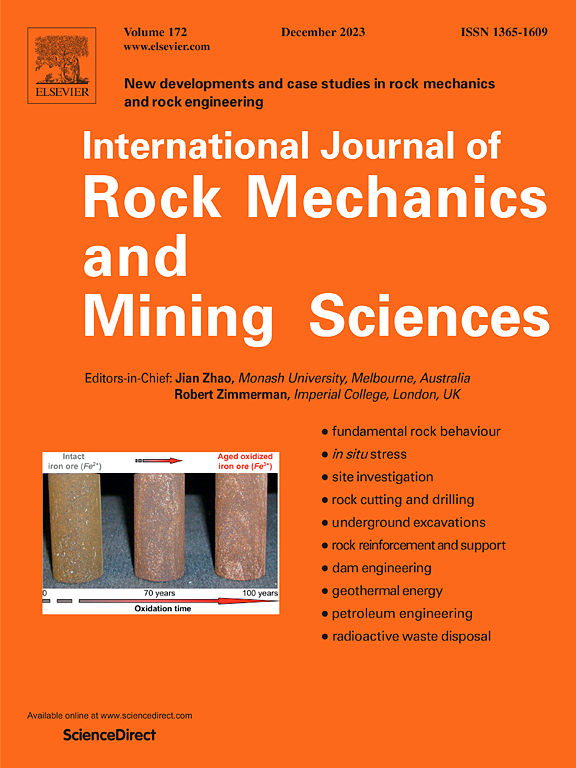3D in-situ stress prediction for shale reservoirs based on the CapsNet-BiLSTM hybrid model
IF 7.5
1区 工程技术
Q1 ENGINEERING, GEOLOGICAL
International Journal of Rock Mechanics and Mining Sciences
Pub Date : 2024-10-28
DOI:10.1016/j.ijrmms.2024.105937
引用次数: 0
Abstract
In-situ stress is essential in shale reservoir fracturing, driving oil and gas migration and informing wellbore stability and drilling optimization. The accurate prediction of 3D in-situ stress is inseparable from seismic data. However, existing methods predominantly rely on empirical formulas or simplified assumptions, which limit their accuracy in representing the real distribution of in-situ stress. Furthermore, these methods often predict in-situ stress from a single factor, leading to high uncertainty. To address these, we propose a method for predicting 3D in-situ stress that leverages a hybrid Capsule Network-Bidirectional Long Short-Term Memory (CapsNet-BiLSTM) model. This approach takes into account various factors, such as geological features and seismic attributes, to achieve more accurate predictions. First, we analyze the structural characteristics of shale formations and use rock petrophysical knowledge to reasonably filter input data, eliminating the impact of redundant parameters on in-situ stress prediction. Then, to overcome the limitations of traditional deep learning models in capturing correlations within complex data structures, we construct a CapsNet-BiLSTM network model. This model integrates the spatial relationship modeling capability of CapsNet and the temporal modeling capability of BiLSTM, better accounting for the anisotropic features and temporal sequence information of shale reservoirs. Applying this method to a study area in the Sichuan Basin demonstrates that the constructed CapsNet-BiLSTM hybrid model accurately predicts in-situ stress values, effectively capturing the spatial distribution patterns of complex in-situ stress within shale reservoirs, thus proving the effectiveness and potential of our method in geological engineering applications for shale oil and gas reservoirs. This hybrid model-based prediction method not only improves the accuracy of in-situ stress prediction but also provides a valuable methodological and technical support for scientific research and engineering practices in related fields.
基于 CapsNet-BiLSTM 混合模型的页岩储层三维原位应力预测
原位应力对页岩储层压裂、油气迁移以及井筒稳定性和钻井优化至关重要。三维原位应力的准确预测与地震数据密不可分。然而,现有方法主要依赖于经验公式或简化假设,这限制了其在表示原位应力真实分布方面的准确性。此外,这些方法往往从单一因素预测原位应力,导致高度不确定性。为了解决这些问题,我们提出了一种利用胶囊网络-双向长短期记忆(CapsNet-BiLSTM)混合模型预测三维原位应力的方法。该方法考虑了地质特征和地震属性等各种因素,以实现更准确的预测。首先,我们分析了页岩层的结构特征,并利用岩石岩石物理知识合理过滤输入数据,消除了冗余参数对原位应力预测的影响。然后,为了克服传统深度学习模型在捕捉复杂数据结构中相关性方面的局限性,我们构建了一个 CapsNet-BiLSTM 网络模型。该模型集成了 CapsNet 的空间关系建模能力和 BiLSTM 的时间建模能力,更好地考虑了页岩储层的各向异性特征和时序信息。将该方法应用于四川盆地的一个研究区域表明,所构建的CapsNet-BiLSTM混合模型能够准确预测原位应力值,有效捕捉页岩储层内复杂原位应力的空间分布模式,从而证明了我们的方法在页岩油气藏地质工程应用中的有效性和潜力。这种基于混合模型的预测方法不仅提高了原位应力预测的准确性,而且为相关领域的科学研究和工程实践提供了宝贵的方法和技术支持。
本文章由计算机程序翻译,如有差异,请以英文原文为准。
求助全文
约1分钟内获得全文
求助全文
来源期刊
CiteScore
14.00
自引率
5.60%
发文量
196
审稿时长
18 weeks
期刊介绍:
The International Journal of Rock Mechanics and Mining Sciences focuses on original research, new developments, site measurements, and case studies within the fields of rock mechanics and rock engineering. Serving as an international platform, it showcases high-quality papers addressing rock mechanics and the application of its principles and techniques in mining and civil engineering projects situated on or within rock masses. These projects encompass a wide range, including slopes, open-pit mines, quarries, shafts, tunnels, caverns, underground mines, metro systems, dams, hydro-electric stations, geothermal energy, petroleum engineering, and radioactive waste disposal. The journal welcomes submissions on various topics, with particular interest in theoretical advancements, analytical and numerical methods, rock testing, site investigation, and case studies.

 求助内容:
求助内容: 应助结果提醒方式:
应助结果提醒方式:


